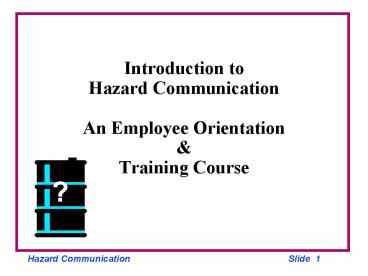Introduction to Hazard Communication An Employee Orientation & Training Course - PowerPoint PPT Presentation
1 / 15
Title:
Introduction to Hazard Communication An Employee Orientation & Training Course
Description:
Hazard Communication An Employee Orientation & Training Course? Introduction to Hazard Communication PREMISE: Employees have a need and a right to know the hazards ... – PowerPoint PPT presentation
Number of Views:95
Avg rating:3.0/5.0
Title: Introduction to Hazard Communication An Employee Orientation & Training Course
1
Introduction toHazard CommunicationAn Employee
OrientationTraining Course
2
Introduction toHazard Communication
- PREMISEEmployees have a need and a right to
know the hazards and identities of the chemicals
that they work with, and employees working with
hazardous chemicals must be provided with the
work procedures and equipment to prevent injury
and illness.
3
Federal OSHA StandardOverview
- Also known as the HazCom or Employee Right to
Know regulation - Applies to general industry
- Covers most chemicals
- Concerned with both physical hazards and health
hazards - Requires a written Hazard Communication program
for regulated employers
4
Employer Responsibilities
- Identify and locate hazardous materials in the
workplace - Inform employees of these materials
- Train employees to be able to detect the presence
or release of these materials - Train employees to use safe work practices,
emergency procedures and personal protective
equipment - Inform employees of the location of the
facilitys written Hazard Communication program,
MSDSs, labeling system, and how to use them
5
Hazard Communication Process
- Information prepared by chemical manufacturers
and importers - Labels to be attached to shipping containers
- Material Safety Data sheets (MSDSs) to accompany
shipment - Employer makes the information available to
employees - Employer trains employees to use information
6
Hazardous Material Definition
- Most chemical products used in the workplace
- Materials with known physical or health hazards
- a. Flammable
- b. Toxic
- c. Caustic
- d. Reactive
- e. Carcinogens
7
Health Hazards of Hazardous Materials
- Acute vs. chronic effects
- Routes of entry into body- Inhalation-
Ingestion- Absorption
8
Labeling Requirements
- In-plant containers of hazardous materials must
be labeled, tagged, or marked with material
identity and appropriate warning - Containers of transferred material, such as
in-process containers, must also be labeled,
unless they are used immediately - Labels are to contain an identifying name, a
hazard warning, and frequently, precautionary
measures - Never remove labels
- Dont mix chemicals that do not have labels
9
Material Safety Data Sheets (MSDS)
- 4 BASIC CATEGORIES
- Product Information
- Exposure Situations
- Hazard Prevention and Protection
- Other Specific Information
10
Material Safety Data Sheets (MSDS)Product
Information
- Chemical name
- Manufacturers name, address, phone number
- Preparation or revision date of the MSDS
- Ingredients of the material (unless it is a trade
secret) - Exposure limits
- Physical and health hazards
- Emergency phone numbers
11
Material Safety Data SheetsExposure Situations
- First aid information
- Spill / leak control information
- Firefighting information
- - Flammable limits
- - Flashpoint temperature
- - Auto-ignition temperature
12
Material Safety Data SheetsHazard Prevention
Protection
- Safe handling and storage precautions
- Engineering controls
- Physical and chemical properties
- Stability and hazardous release from
decomposition of materials - Reactions with other chemicals
- Recommended use of personal protective equipment
13
Material Safety Data SheetsOther Specific
Information
- Toxicological information
- Environmental information
- Disposal information
- Regulatory information
- Transportation information
14
Continuous Program Maintenance
- New employee orientation
- Changes in substances handled
- Updates in MSDS information
- Changes in the operational processes
15
HAZARD COMMUNICATION
- Final Discussion
- Question and Answer Period































